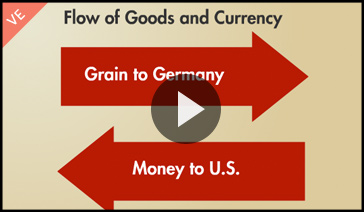
Grades 9-12
Happy EconEdMonth! Celebrate economics all month long by visiting EconEdMonth.org

Don't have an account yet? Sign up for free
Don't have an account yet? Sign up for free


Students will learn that most countries create their own currency for use as money. In most of Europe that money is now the Euro. Students will discover the use of Euros in this simulation and learn a little about exchanging dollars for Euros.
Would you like to take a trip to Europe? It might surprise you that your dollar bills and coins would not be accepted in the stores in Europe. In fact, the dollar is not normally accepted except in the United States. If you went into a McDonald’s in Japan, South Africa, Ecuador, or even Canada you would not be able to spend your American money. In this lesson you will discover that Europe has a new currency unit called the Euro. You will also find out that one dollar does not equal one euro.
stores in Europe. In fact, the dollar is not normally accepted except in the United States. If you went into a McDonald’s in Japan, South Africa, Ecuador, or even Canada you would not be able to spend your American money. In this lesson you will discover that Europe has a new currency unit called the Euro. You will also find out that one dollar does not equal one euro.
https://www.merriam-webster.com/dictionary/centimes defines centimes (‘sän-"tEm) as the French word for 100 cents. To hear the pronunciation of centime click on the link above and type in centime.
In America we use money that we call dollars. Canadians use dollars too. The fact that confuses most kids (and a lot of adults!) is that one Canadian dollar does not equal one American dollar! The Canadian dollar is in fact a distinct, Canadian unit of currency; it simply has the same name as the name of the U.S. currency–the dollar. However, there is an exchange rate between Canada and the United States that tells us how the two dollars compare. An exchange rate is the price of one nation's currency in terms of another nation's currency.
Exchange rates vary every day. As of today (the day on which I am writing) the Canadian dollar is worth 66 cents in American money and one American dollar is worth $1.59 in Canadian money. You can check exchange rates between two countries by using this https://www.xe.com/currencyconverter/
If a Big Mac combo meal costs $3.49 in US dollars, go to the currency converter site above and find out how much one costs in Canada.
In Europe, beginning in January 2002, 12 European nations started using one unit of currency: the euro. Before 2002, France and Belgium had a currency based on francs, Germany had the Deutsche mark, and Ireland had the pound. Now those European countries and seven others use the euro. The common currency makes traveling and trading am ong European countries easier. Britain, Denmark, and Sweden have not replaced their currency with the euro.
ong European countries easier. Britain, Denmark, and Sweden have not replaced their currency with the euro.
On the website below you are going to take a tour of France, be given an allowance in pretend American money, go on a shopping spree, learn about the franc and the euro, and see exchange rates in action. Then you will take a quiz to see how much you have learned. Go to the https://www.usmint.gov/learn/kids website. Then click on the plane with the name "Coins of the World" below it. For the text-based version, click on Online Storybook in the paragraph about Coins of the World.
The students have learned that the euro is Europe’s common currency today. They have seen exchange rates in action. They have been exposed to the idea that money is minted in different countries, and units of currency from different countries are not automatically exchanged at one-for-one rates.
Go to the Childrens Money World website for some fun with the euro. This site has some information not found in the lesson. This site is also expanding each month. Eventually the site will have euro characters that will sing about their appearance and their amount. Free registration is also required to use the website.
Jigzone.com put together a puzzle of a 200 euro with euro pieces.
The series of questions at the end of the web site checks students on concepts they should know. Students are rewarded with a page of money in the animated version and a certificate in the online storybook form.

Grades 9-12

Grades 9-12

Grades 6-8, 9-12

Grades 6-8, 9-12
